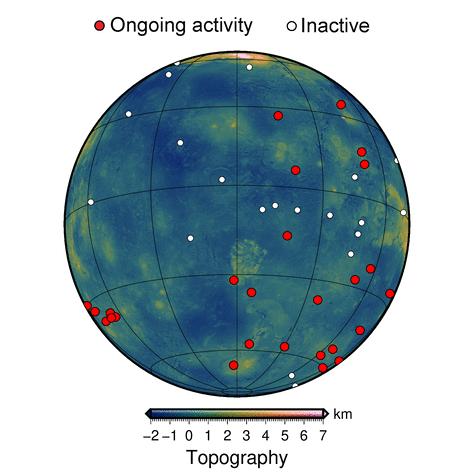Concept art of volcanoes on Venus. Image: NASA/JPL-Caltech/Peter Rubin
Scientists have identified at least 37 volcanically active regions on Venus, suggesting that the planet may not be as geologically inert as previously expected. The discovery sheds light on a key mystery about Venus, a world that is notoriously difficult to study because of its thick cloudy atmosphere and hellish surface conditions.Scientists led by Anna Gülcher, a geophysicist at ETH Zürich in Switzerland, modeled the planet’s “coronae,” which are circular structures that indicate geological activity, and compared those simulations to known surface features on Venus.“Our study presents new evidence for recent tectonic and magmatic activity on the surface of Venus, complementing other indications of such activity,” said Gülcher and her colleagues in a study published on Monday in Nature Geoscience.However, the compelling findings do not explain the broader geological dynamics that are occurring within Venus and on its surface. “Whether Venus is geologically active today, and to what extent surface tectonics reflect the current state of the planet’s interior, remains in question,” the team wrote.Scientists have known for decades that the surface of Venus is young compared to Earth and Mars, likely because subterranean magma erupts into lava flows that smooth over the Venusian landscape.However, it’s not clear how these volcanic processes work on the planet, especially given that Venus does not have the kind of global tectonic activity that we see on Earth. Venus is pockmarked by hundreds of coronae that range from about 60 to 1,000 kilometers in diameter, but these hotspots are likely caused by regional interactions between mantle plumes—filaments of hot molten rock from the planet’s interior—and the outer crust, or lithosphere, of Venus. Coronae may form on Venus wherever magma plumes are able to penetrate thinner stretches of the lithosphere. One big question is whether these flows are currently erupting on Venus or if the planet is now dormant after a burst of volcanic activity that occurred sometime in the past few million years.Gülcher and her colleagues ran 3D numerical models that simulated this plume–lithosphere interaction on Venus, which helped the team isolate coronal features that indicate that they are currently active. Once they had figured out the likely signatures of active coronae in the high-resolution simulations, the researchers sought to match them with features on real topographical maps of the planet.“A corona is labelled as currently ‘active’ if it features a clear outer rise and trench, ‘inactive’ if no trench or outer rise but a rim and inner depression is evident, or ‘unclassified’ if the presence of these features is ambiguous,” the team said in the study.“A morphological analysis of large existing coronae leads to the conclusion that at least 37 large coronae (including the largest Artemis corona) are active, providing evidence for widespread ongoing plume activity on Venus,” the researchers added.In addition to pinpointing hotspots on Venus, Gülcher and her colleagues showed that the planet’s coronae represent different phases in the evolution of plume-lithosphere interactions. In other words, some of the coronae are inactive vestiges of ancient eruptions, others are currently active, and some are only temporarily dormant.While the study presents some of the strongest evidence for ongoing volcanic activity on Venus, there are still plenty of mysteries left to solve about the planet. That’s why Gülcher’s team concludes that these coronae would make for “interesting targets for detailed investigation by future spacecraft missions,” according to the study.“Any future mission that would collect more and higher-resolution topographic and geodynamic data of the planet would help further determine the activity of coronae and other geological/volcanic features, substantially contributing new understanding of the interior dynamics of Venus and the evolution of terrestrial planets in general,” the researchers said.
Coronae may form on Venus wherever magma plumes are able to penetrate thinner stretches of the lithosphere. One big question is whether these flows are currently erupting on Venus or if the planet is now dormant after a burst of volcanic activity that occurred sometime in the past few million years.Gülcher and her colleagues ran 3D numerical models that simulated this plume–lithosphere interaction on Venus, which helped the team isolate coronal features that indicate that they are currently active. Once they had figured out the likely signatures of active coronae in the high-resolution simulations, the researchers sought to match them with features on real topographical maps of the planet.“A corona is labelled as currently ‘active’ if it features a clear outer rise and trench, ‘inactive’ if no trench or outer rise but a rim and inner depression is evident, or ‘unclassified’ if the presence of these features is ambiguous,” the team said in the study.“A morphological analysis of large existing coronae leads to the conclusion that at least 37 large coronae (including the largest Artemis corona) are active, providing evidence for widespread ongoing plume activity on Venus,” the researchers added.In addition to pinpointing hotspots on Venus, Gülcher and her colleagues showed that the planet’s coronae represent different phases in the evolution of plume-lithosphere interactions. In other words, some of the coronae are inactive vestiges of ancient eruptions, others are currently active, and some are only temporarily dormant.While the study presents some of the strongest evidence for ongoing volcanic activity on Venus, there are still plenty of mysteries left to solve about the planet. That’s why Gülcher’s team concludes that these coronae would make for “interesting targets for detailed investigation by future spacecraft missions,” according to the study.“Any future mission that would collect more and higher-resolution topographic and geodynamic data of the planet would help further determine the activity of coronae and other geological/volcanic features, substantially contributing new understanding of the interior dynamics of Venus and the evolution of terrestrial planets in general,” the researchers said.
Advertisement

Advertisement
